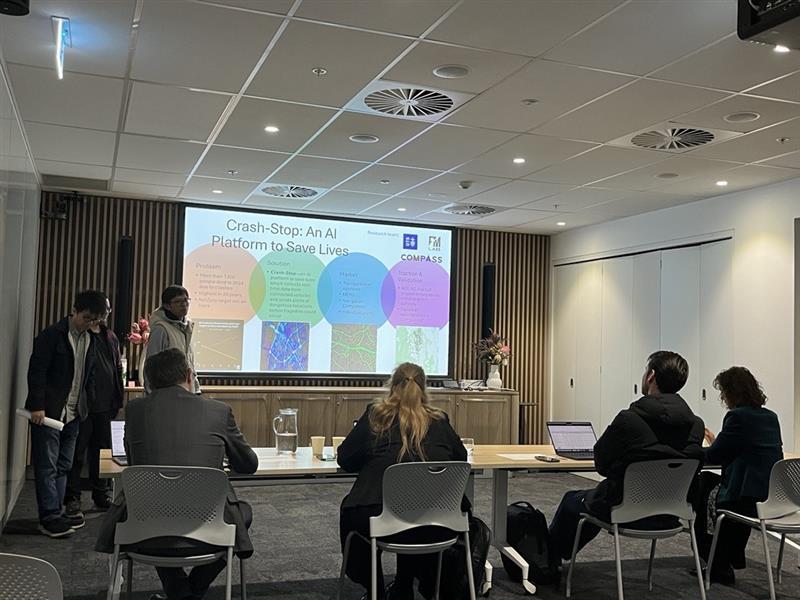Australia faces a devastating road safety crisis with 1,300 traffic fatalities that have occurred in 2024, the highest in 12 years, putting the national goal of zero road deaths by 2030 severely off track. Transportation agencies, city councils, and road safety authorities are struggling with a fundamental problem: they can only respond AFTER crashes have occurred.
Using AI to identify, predict and prevent traffic crashes

Caption
Dr Artur Grigorev, Dr Tuo Mao, and Dr Yuming Ou presenting at the Research Translation Competition 2025
A UTS team is addressing this challenge by creating an AI platform that prevents traffic accidents before they happen.
Unlike traditional approaches that react after crashes occur, their system proactively identifies dangerous road locations by analysing real-time data from connected vehicles. The technology detects near-miss incidents, sudden braking, and risky driving behaviours to predict where accidents are most likely to occur.
As part of this year’s UTS Research Translation Competition, Dr Simona Mihaita, Dr Artur Grigorev, Dr Tuo Mao, and Dr Yuming Ou presented their solution for identifying, predicting and preventing traffic crashes using AI technology.
As the Australian government and transport agencies struggle to implement an effective solution, the team have developed Crash-Stop, an AI platform that collects and analyses data to predict severe manoeuvres and traffic crashes before they occur and provide alerts in real time.
The UTS team has been closely working together with Compass IoT, an Australian startup offering real-time connected vehicle data which can fuel the next generation of vehicle intelligence programs.
“Our team’s value lies in our combination of multidiscipline expertise including artificial intelligence, transport engineering and data science,” Tuo said.
“We’re not only building a tool to prevent crashes, but we are building a way to render a crash.”
Using a preventative approach
The team’s solution focuses on the importance of a preventative approach over reactive measures, capturing data on near misses as well as actual crashes.
Artur pointed out that while the Australian Automobile Association have agreed to aggregate data and provide safety ratings for around 500, 000 Australian roads, such ratings are static.
If we look at specific areas with a high amount of severe manoeuvres, we can prevent crashes instead of focusing on crash data alone.
“By using our new data, which now includes ‘near misses’, we are taking a preventative approach,” Artur said, adding that availability of near miss data is much higher than crash data and the team’s approach involves identifying areas where drivers perform severe manoeuvres.
“If we look at specific areas with a high amount of severe manoeuvres, we can prevent crashes instead of focusing on crash data alone.”
“We believe the best crash is a crash that never happens,” Tuo added.
The Research Translation Competition experience
Simona said the Research Translation Competition was a useful learning experience.
“The Competition opened our eyes regarding what a successful research idea could be and encouraged us to think in a commercial driven way rather than in an engineering and development fashion.”
Simona encouraged other research colleagues to get involved.
The Competition opened our eyes regarding what a successful research idea could be and encouraged us to think in a commercial driven way rather than in an engineering and development fashion.
“You will think of many aspects of what a startup spinning from research can be, how it can succeed and mostly, how it can quickly fail,” she said.
What’s next?
- Join the Research Translation Cafe on Tuesday October 28, 2pm - 4pm in RES Hub.
- Learn more about the Research Translation Competition.